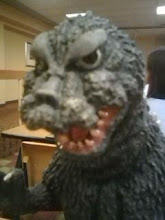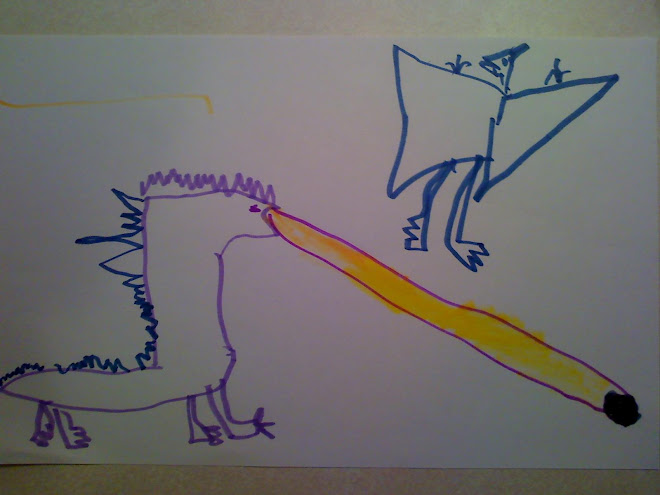 A blog posting by Brett Homenick led me back to issue #81 of G-FAN, and I am glad it did. This may have been the second issue I received via subscription, and it was a fun one to revisit.
A blog posting by Brett Homenick led me back to issue #81 of G-FAN, and I am glad it did. This may have been the second issue I received via subscription, and it was a fun one to revisit.Things get off to a solid start with "Singing for the Smog Monster," Homenick's interview with Adryan Russ, the co-writer and singer of "Save the Earth." Her memories of writing and recording the song are vivid, and she seemed genuinely pleased to have been contacted about it. That is followed by Homenick's discussion with Don Frye of Godzilla: Final Wars, who wins the reader over with his humility (he describes himself as "a giraffe on roller skates on an ice pond" in relation to other actors). Mike Bogue salutes It Came from Beneath the Sea, noting that Eiji Tsuburaya seemed to have a thing for octopi.
"Godzilla's Most Embarrasing Moments" comes next. Ken Bockelman does a fine job pointing out Godzy's goofiest gaffes (led by "The Neverending Drop Kick" from Godzilla vs. Megalon).
Don Jolly's "Growing Up with G-FAN" is a heartfelt tribute to the 'zine itself. Most Godzilla lovers will find it easy to relate to Jolly's enthusiasm and his description of the sometimes solitary nature of G-fandom.
Homenick returns with interviews of George Touliatos and Michael Lennick, both of whom worked on Virus.
Mark Justice's "Shinto Symbolism in Toho's Daikaiju Eiga" helps provide subtext for the films' prevalent images. One minor quibble I have with the article is that it neglects to mention the Christian symbolism especially evident in the Japanese version of Mothra--although that admittedly falls outside its stated scope.
Brett Homenick talks to Godzilla: Final Wars' Jonathan Legg, who shares an amusing anecdote about Don Frye's arm wrestling prowess.
John Le May's "Up From the Depths" is a kaiju-inspired sampling of real-life lake monster reports, drawing on the works of cryptozoologists such as Loren Coleman and Karl Shuker. I am always happy to see such articles in G-FAN, as I think there is a natural cross-over between an enjoyment of giant cinematic monsters and an open-mindedness regarding the potential existence of such creatures in our world.
Mike Bogue's "Alternate Monsterverse" is a testament to his own creativity and imagination, growing up, as he did, with nary a Bandai figure (or even a Shogun Warriors Godzilla) with which to play.
Armand Vaquer contributes an interview with genre historian August Ragone, who talks about the path his Tsuburaya biography took to publication, along with sharing his memories of his first exposures to Godzilla and Ultraman. Vaquer then reviews Ragone's "Eiji Tsuburaya: Master of Monsters," rightly describing it as a "labor of love" and "one of the most important, if not the most important, movie books on Japanese science-fiction to come out in years." I couldn't agree more.
Ragone himself checks in with a remembrance of the life and personality of the multi-talented Jerry Ito. Included is a moving description of Ito's 2004 reunion with Mothra co-star Hiroshi Koizumi.
Brett Homenick presents a conversation with Luciana Paluzzi (the article that sent me back to this issue) and the star of The Green Slime speaks with candor about her surprise at the cult movie's enduring appeal and her experiences during filming.
David McRobie's "The Globe Meter" reviews a variety of treats, such as Ultraman Mebius and the Ultra Brothers and The Host (which gets a thorough and thoughtful review later in the issue).
Armand Vaquer returns with an informative look at the Fukuoka Dome, a 48,000-seat arena that is central to the action in Gamera, Guardian of the Universe. It is nice to know that the issue of "naming rights" is not purely American (the structure is now known as "The Fukuoka Yahoo! Japan Dome)!
Also included is a highly illustrated retrospective of G-FEST XIV, which featured guests Shelley Sweeney and Rhodes Reason, and Steve Agin's traditional toyfest summary.
Issue #81 is highly informative. The spotlight on Ragone's book was especially warranted and was done well. The sheer volume and quality of Brett Homenick's interviews should not be overlooked, either. He seems to be able to bring out the best in those with whom he speaks and presents them in the best possible light. The variety of writing styles, subjects, and visuals (beginning with the ominous cover) makes this issue one that stands up to repeated, satisfying reading.


































































Wow!! "It Came From Beneath the Sea" was the first monster movie I ever saw. I think my Dad took me to see it when I was a kid. That make four generations of us that have enjoyed the genre.
ReplyDeleteAnother excellent review, Mark! What can I say? I'm touched by your kind words.
ReplyDelete